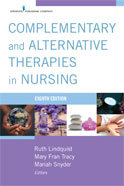Complementary and Alternative Therapies in Nursing This title has been archived.

Author: Ruth Lindquist, PhD, RN, FAHA, FAAN, Mary Tracy, PhD, RN, APRN, CNS, FAAN, Mariah Snyder, PhD, RN
Affiliation: University of Minnesota School of Nursing, Minneapolis, MN
Publisher: Springer Publishing Company
Publication Date: 2018
ISBN 10: 0826144330
ISBN 13: 9780826144331
eISBN: 9780826144348
Edition: 8th
Affiliation: University of Minnesota School of Nursing, Minneapolis, MN
Publisher: Springer Publishing Company
Publication Date: 2018
ISBN 10: 0826144330
ISBN 13: 9780826144331
eISBN: 9780826144348
Edition: 8th
Description:
Now in its eighth edition, this highly acclaimed, newly revised and expanded text continues to deliver innovative practice guidelines for evidence-based complementary and alternative therapies that can easily be incorporated into curriculum and applied directly to practice. The book describes holistic treatments that are culturally appropriate for clients across the life span and NCLEX®-relevant content appropriate for preparation of advanced practice nurses.
The eighth edition reflects an expanding interest in these therapies worldwide and features numerous sidebars by international contributors who provide a global perspective that builds readers’ understanding of the cultural derivations and uses of complementary therapies. The new edition also highlights digital and technical advances, provides key updates to foundations for practice, and describes cutting-edge research. Included is a description of the evolution and establishment of the National Center for Complementary and Integrative Health (NCCIH) and its current national agenda. Updated legal information regarding regulation and credentialing, enlarged safety and precaution content, and the inclusion of a broad range of therapies add to the utility of this new edition.
The only book about complementary and alternative therapies written specifically for nurses that focuses on essential evidence for practice, the text uses a consistent format to present a definition and description of each therapy, a summary of how it evolved, and a rationale for its use. The scientific basis and research evidence for use of each therapy in a variety of specific patient populations is emphasized. Sidebars in each chapter describe the use of various therapies in different settings worldwide. All chapters provide practical guidelines for using the therapies to promote health and comfort while increasing patients’ well-being and satisfaction with care.
Related Titles
